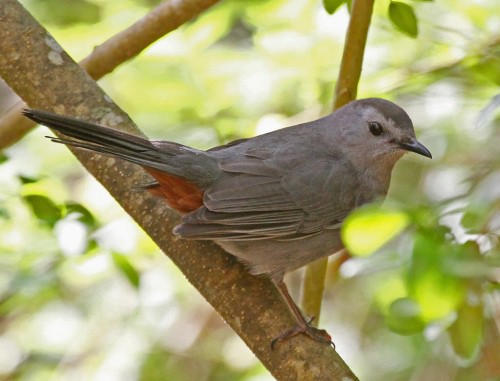Because the semester was winding down, I wasn’t all that surprised to hear a soft, kittenish mewing coming from the small wedge of remnant wooded habitat between my apartment parking lot and the highway. I used to live in a complex near the Virginia Tech campus and, sadly, it’s common for a new crop of outdoor cats to appear as the students disappear.

This is not unique to any particular school—it happens in college communities all across the country. People often believe cats are more independent and able to live on their own than dogs… that misperception may have something to do with the lack of guilt they seem to feel over abandoning their once-beloved pet.
But as I scanned the underbrush looking for the source, thinking of what I might use to coax a frightened feline to come out, come out, wherever it was, I came to the happy realization that I wouldn’t be making a trip to the animal shelter after all. It had been a long time since I’d heard a gray catbird (Dumetella carolinensis), and never was I more thrilled by a tune in the trees than on that Sunday morning.
Their call may be the world’s easiest to recognize. Once you’ve heard that “meow,” you won’t wonder another minute how the catbird caught its moniker. Like their relatives, the mockingbirds and thrashers, these birds are able to copy other sounds and string them together to create a clever mash-up. But their signature song isn’t a case of mimicry—its all their own, shared by every member of the species.
Once my ears were retuned, I heard catbirds calling all over town—another reason to be happy, because this species, which is pretty common in most of its range, has been in decline recently in the southeastern U.S. You’d never know it in Blacksburg, though, where it can sound as though litters of catbirds have been turned loose in the woods.
If not for that distinctive call, you might not even notice these secretive birds. They don’t like to cross open areas so they stick to the thickets, moving in quick hops and short flights through dense vegetation as they search for insects and berries. At first glance, a catbird’s plumage is unremarkable. But look again and you’ll see that slate gray gives way to a jaunty black cap and tail. Look even more closely and you’ll see a rich rusty-orange patch just beneath the tail. That bright flash of pigment always takes me by surprise and makes me laugh—it’s like catching a glimpse of a colorful thong or boxers peeking out of a staid gray flannel suit!
An example of the gray catbird’s diverse playlist — the first “meow” call is at about the 13 second mark.
Do you have questions about wildlife? Email NDN and the answer may turn up as a future blog post. And don’t forget to “Like” us on Facebook!
© 2011 Next-Door Nature— no reprints without written permission from the author.
Kieran Lindsey
Kieran Lindsey loves looking for wild things in all the wrong places... so she became an urban biologist. Her quest to entice others to share this passion led to flirtations with (gasp!) the media—as a columnist for the Houston Chronicle; as host of KUNM-FM’s Wild Things; as producer of an Emmy® winning wildlife documentary; and at her Next-Door Nature blog. Kieran has way too much fun as official Animal-Vehicle Biologist for NPR's Car Talk, and she isn’t ashamed to admit it.

Leave a Reply